
|
xTuple ERP Reference Guide |
Accounts are central to the xTuple system. An account holds information about an entity and serves to define it further as a customer, prospect, vendor, competitor, or partner. To create a new account, go to . The following screen will appear.
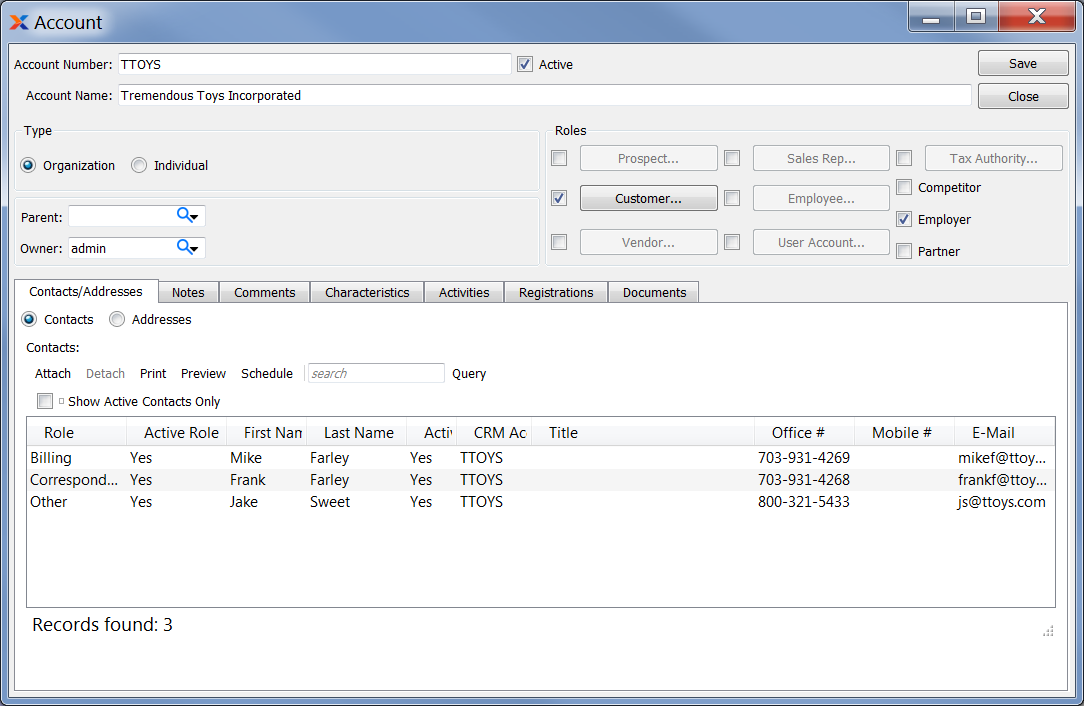
When creating a new account, you are presented with the following options:
The account number uniquely identifies the account. Users must have sufficient privileges to change the account number, particularly when the account extends to different types (e.g., customer, vendor, etc.). If the number is linked to a user account, the change can only be made by a superuser.
Enter the name of the account you do business with (e.g., customer name or vendor name). This field should not to be confused with the contact name of an individual at the company. Users must have sufficient privileges to change the account name, particularly when the account extends to different types (e.g., customer, vendor, etc.).
Select if you are actively doing business with this account. Not selecting makes the account inactive.
Specify one of the following account types:
Select if the account is an organization.
Select if the account is an individual.
Enter the account number of the account (if any) which serves as the parent for the account. All contacts and comments associated with the child account record will be inherited by and displayed in the parent account record.
Enter a contact who serves as the owner of the account.
Indicate how the account relates to your business by selecting from the available options. A single account may have multiple different roles. Users with sufficient privileges may access each of the roles by clicking on the associated buttons.
Select if the account is a prospect. Specific prospect information is maintained on the Prospect screen, which can be reached by selecting the button.
Select if the account is a customer account. Specific customer information is maintained on the Customer screen, which can be reached by selecting the button.
Select if the account is a vendor account. Specific vendor information is maintained on the Vendor screen, which can be reached by selecting the button.
Select if the account is a sales representative. Specific sales rep information is maintained on the Sales Rep screen, which can be reached by selecting the button.
Select if the account is an employee. Specific employee information is maintained on the Employee screen, which can be reached by selecting the button.
Select if the account is a user. Specific user information is maintained on the User screen, which can be reached by selecting the button. Changing the account number of a user account requires an admin with superuser privileges.
Select if the account is a tax authority. Specific tax authority information is maintained on the Tax Authority screen, which can be reached by selecting the button.
Select if the account is a competitor. There is no separate screen for maintaining competitor information.
Select if the account is an employer. There is no separate screen for maintaining employer information.
Select if the account is a partner. There is no separate screen for maintaining partner information.
When defining or viewing contacts for the specified account, you are presented with the following options:
For contacts, you have two options:
Attach an existing contact to the account.
Enter new contact information.
Select to attach and/or detach contacts to the account. For additional documentation related to creating contacts, see Section 7.1, “New Contact”.
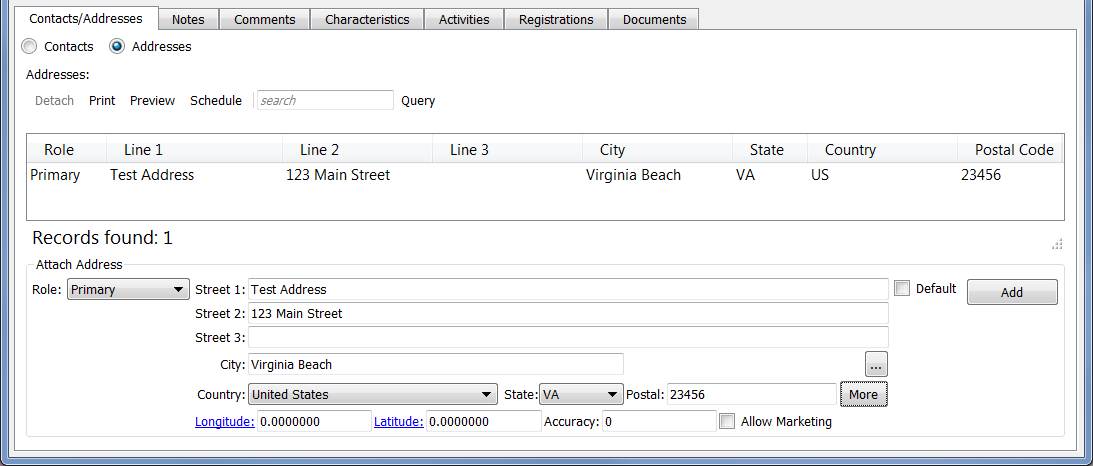
Select to attach or add addresses to the account. If a new address is manually entered here, that information will be added automatically to the master list of addresses. For additional documentation related to creating addresses, see Section 8.1, “ New Address”.
The following buttons are unique to this screen:
To add notes to an account, select the tab. The following screen will appear:

When adding notes to an account, you are presented with the following options:
This is a scrolling text field with word-wrapping for entering notes related to the account. Any notes entered on this screen are for internal purposes only.
To add comments to an account, select the tab at the bottom of the Account screen. The following screen will appear:
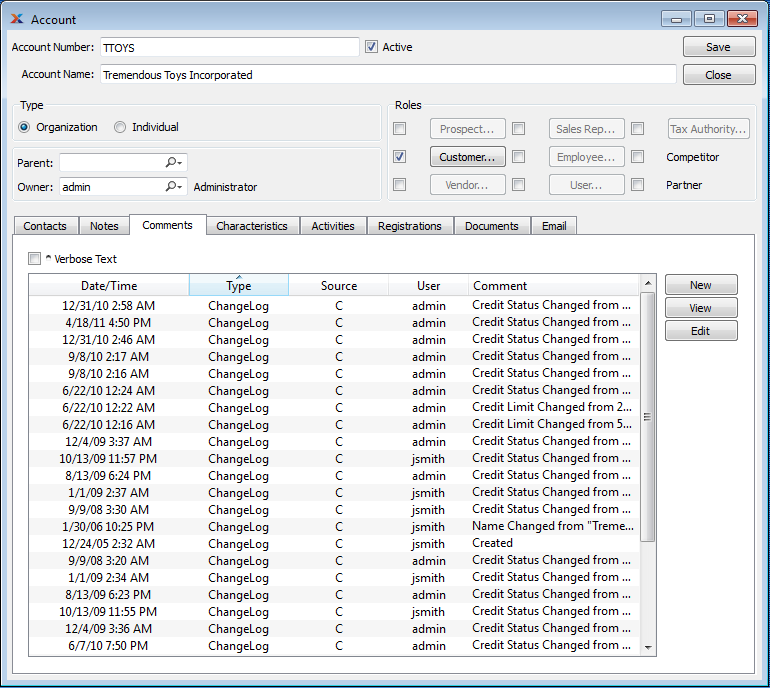
When adding or reviewing comments, you are presented with the following options:
Select to display all comments in the list in an expanded view which includes the entire text of each comment. To edit a comment, simply select the link next to the comment. That link will not be shown for changelog comments, which can't be edited. If the Verbose Text option is not selected, the comment list will display only header level information for each comment.
Display lists comments related to the record.
The following buttons are available:
Opens screen for creating a new comment.
Highlight a comment and then select this button to reach a read-only view of the Edit screen.
Enables you to edit highlighted comments—as long as the comments are not changelog comments. ChangeLog comments are system-generated and may not be edited. The Edit screen is the same as that for creating a new comment—except that when editing, the fields will contain comment information. Double-clicking on a comment will also bring you to the editing screen.
To enter a new comment, select the button. The following screen will appear:

Select a comment type from the drop-down list to classify the comment. This is a required step. Comment types may be system-defined (i.e., changelog and general) or user-defined, as described in Section 13.2.3, “Comment Types”. Once you have specified a comment type, begin typing your comment in the main text area. The text area features word-wrapping and scroll-bar support for longer comments.
The following buttons are unique to this screen:
Select to show the complete list (i.e., thread) of comments associated with the record. To hide the list, simply select the button again. The comment thread will show the most recent comment first.
Account characteristics are user-defined definitions of an account which may be used to provide additional layers of description. To enter characteristics associated with an account, select the tab. The following screen will appear:
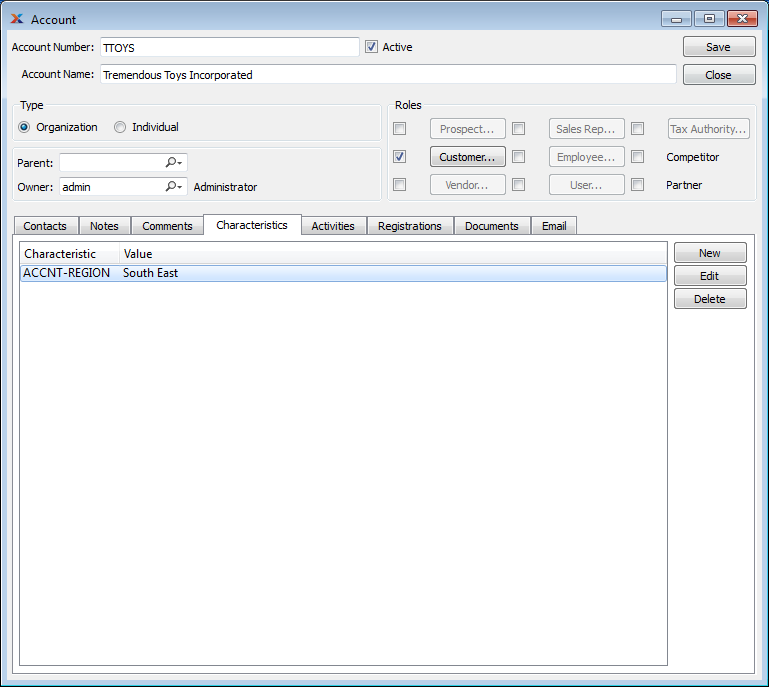
To create a new characteristic for your current context, select the button from the characteristics list. The following screen will appear:
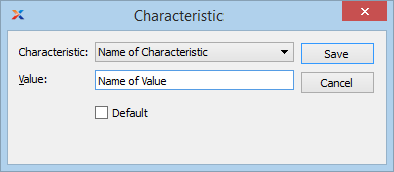
When creating a new characteristic, you are presented with the following options:
Select a characteristic from the list of characteristics available for your current context. To learn more about how characteristics are linked to specific contexts, please see Section 9.2.2.1, “Characteristic”.
Enter a value to associate with the characteristic.
In some contexts, the Default option will appear. Select if the value entered is the default value for the specified characteristic. Default values will always be listed first where characteristics are used.
To enter or associate tasks, opportunities, or incidents with an account, select the tab. The following screen will appear:

When associating tasks, opportunities, or incidents with an account, you are presented with the following options:
Specify which of the following options you want to include in the list:
Select to include tasks in the display. If not selected, tasks will not be included.
Select to include opportunities in the display. If not selected, tasks will not be included.
Select to include incidents in the display. If not selected, incidents will not be included.
Select to include projects in the display. If not selected, projects will not be included.
Select to include the completed activities in the list. If not selected, the completed activities will not be included.
Displays tasks, opportunities, incidents, projects associated with the account.
You have the ability to track lot/serial registrations by account. In most cases, registrations must be manually entered. However, in the case of items sold to customers, the system can be configured to automatically track warranty registrations for you.
If you select the Auto Register Lot/Serial at Shipping option on the item site for an item, then the system will automatically track registrations (by customer) whenever the item is shipped. This applies only to sold items which are lot/serial controlled.
To view a list of lot/serial registrations associated with the account, select the tab. The following screen will appear:
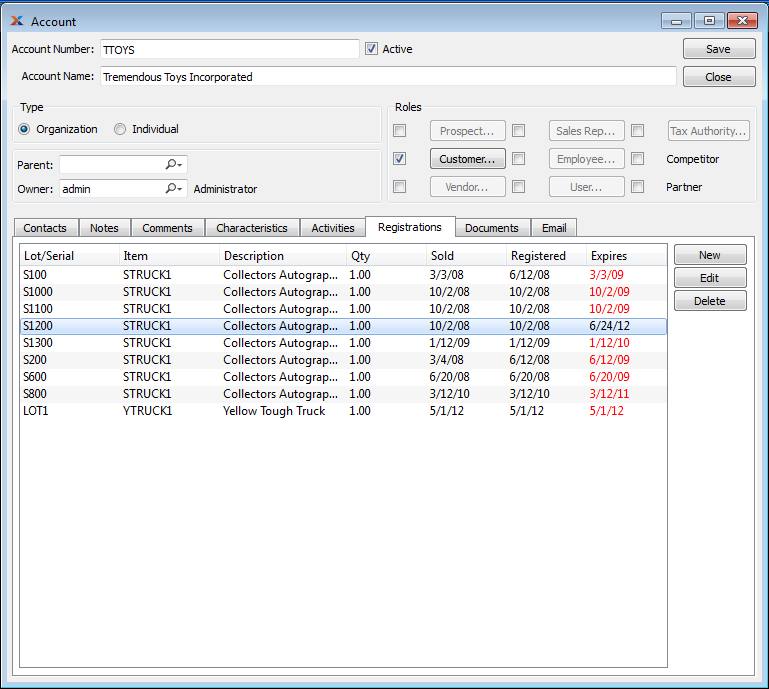
When viewing lot/serial registrations associated with the account, you are presented with the following options:
Display lists lot/serial registrations associated with the account. The process for creating a new lot/serial registration is described in Section 7.1, “Lot/Serial Registration”.
To associate images and files with an account, select the tab. The following screen will appear:

When associating documents, you are presented with the following options:
Select to create a new document and associate it with the current record. You may create the following document types:
Select to create a new image association.
Select to create a new fixed asset association.
Select to create a new maintenance order association.
Select to create a new incident and associate it.
Select to create a new project and associate it.
Select to create a new opportunity and associate it.
Select to create a new task and associate it.
Enables you to edit associated documents. The Edit screen is the same as that for creating a new document—except that when editing, the fields will contain document information. Double-clicking on a document will also bring you to the editing screen.
Highlight a document and then select this button to reach a read-only view of the Edit screen.
Select to associate already-existing documents. The following document types may be attached: contact, account, customer, employee, file, image, incident, item, opportunity, project, purchase order, sales order, vendor, web site, work order.
Highlight a document and then select this button to remove the association.
To associate already-existing documents, select the button. The following screen will appear:
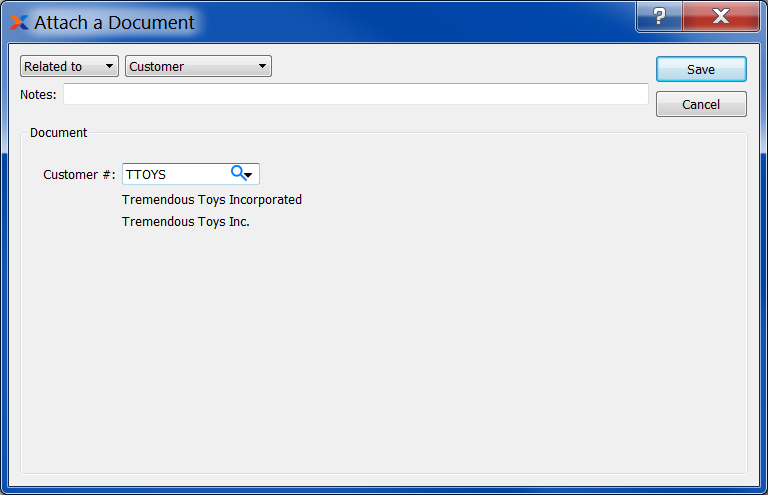
When associating already-existing documents, you are presented with the following options:
Indicate how the document is related to the current record. The following relationship options are available: related to, parent of, child of, duplicate of.
Specify the kind of document you want to associate. The following document types may be attached: contact, account, customer, employee, file, image, incident, item, opportunity, project, purchase order, sales order, vendor, web site, work order. When associating files, you will also be given the option to save the file to the database.
There is no file size restriction when saving files to the database. However, excessively large files could cause storage and performance issues.
Leave any notes on the document file as needed.
Use the lookup tool to identify the specific document you want to attach. The data entry options will vary depending on the document type you select.
To view email associated with the CRM account, select the tab. The following screen will appear:
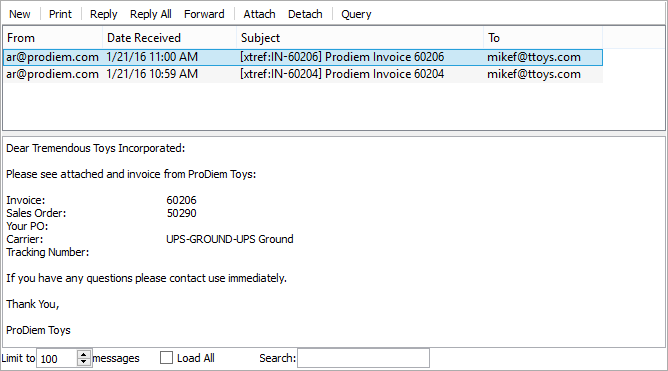
When viewing associated emails, you are presented with the following options:
Display lists associated emails.
The content of a highlighted email will be displayed here.
Specify the maximum number of associated emails you want to be displayed in the email list. If the list is extremely long, you may experience some slowness when opening the screen.
Select to load all associated emails into the list.
Enter a string of letters or complete words to search for matches in the list of associated emails. The search will scan through subject lines, To addresses, and From addresses.
The following buttons are unique to this screen:
Select to send a new email, using the default email program on your computer.
Highlight an email and then select this button to print a copy of the email.
Highlight an email and then select this button to reply to the email's sender, using the default email program on your computer.
Highlight an email and then select this button to reply to everyone associated with the email, using the default email program on your computer.
Highlight an email and then select this button to forward the email to another person(s), using the default email program on your computer.
Highlight an email and then select this button to attach an email associated with a contact in your contact list.
Highlight an email and then select this button to remove the associated email from the list.